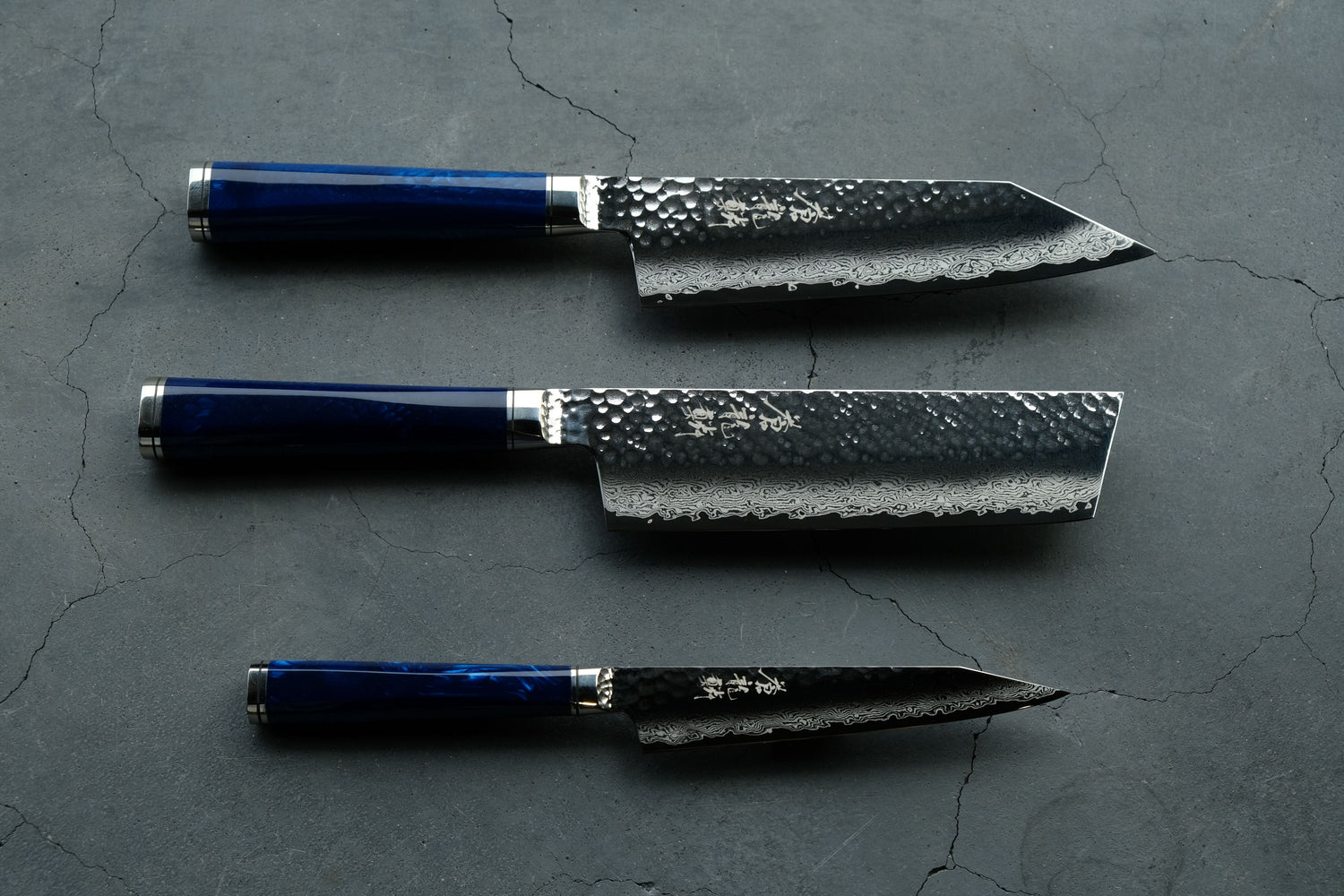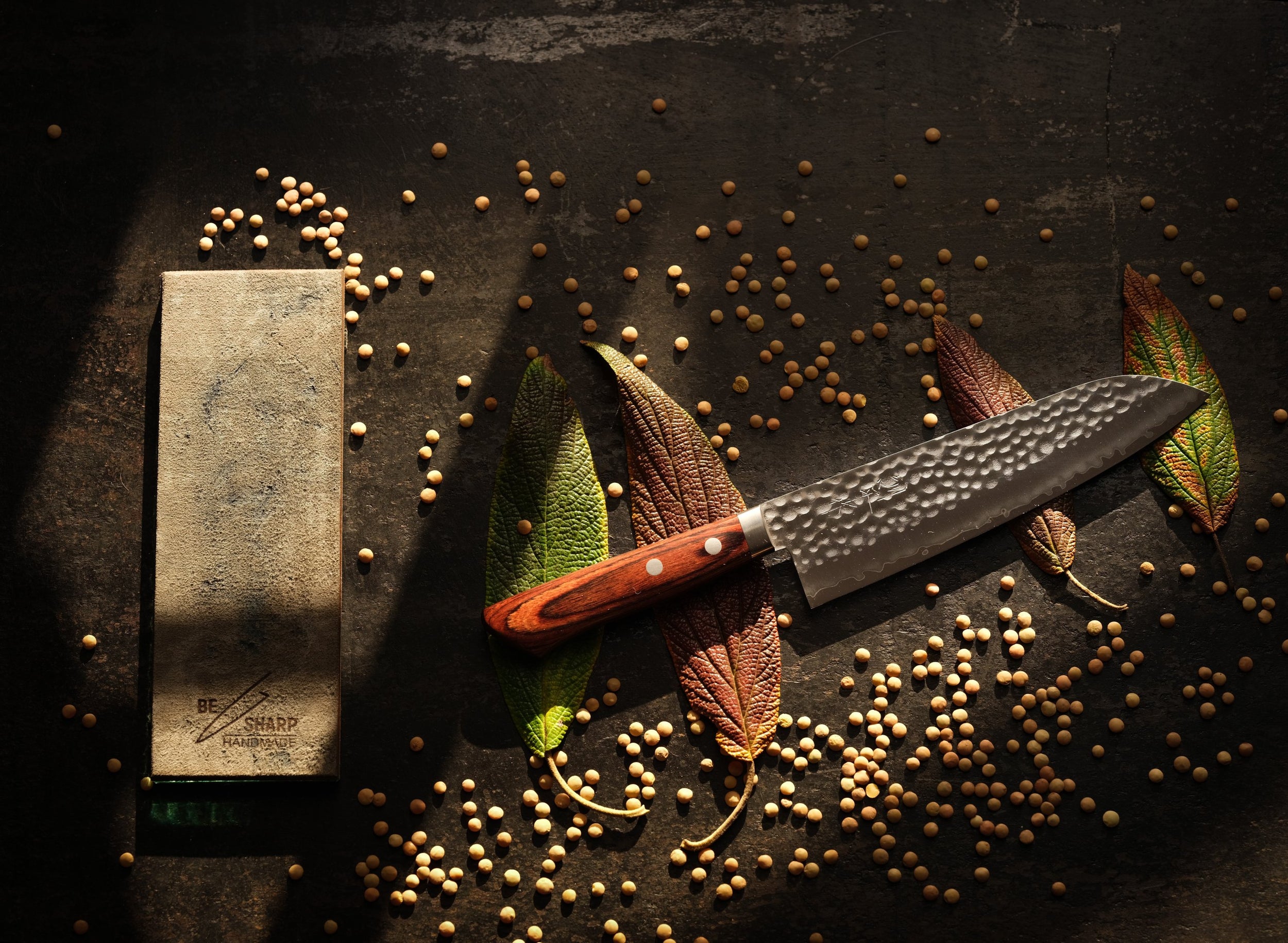Shapes of Japanese knives


If you need to "open the bag" for a knife, then it is definitely Gyuto. Literally translated from Japanese, Gyuto means cow sword. Fortunately, a literal translation is not used in this matter, so we call it the boss knife. This type of knife covers the widest range of needs, with it you can easily chop vegetables and herbs, cut meat, cut skin, and its tip is very convenient for all precise work.
Gyuto knives are produced in different dimensions, starting from 160mm up to 300mm. When choosing this knife it is important to choose the right size for you so that you feel comfortable while using it, as it will be in your hands longer than any other shape of knives. The standard length of the Gyuto knife is 210mm.
Is it because of its functionality or because refined apparently, the Gyuto is definitely the most sought-after Japanese knife in the world. We advise you to first choose the right Gyuto for you, and then the rest of the collection that will go with it.

Santoku refers to a Japanese knife that has a flatter blade profile and a curved tip towards the cutting part. Santoku is one of the most useful knives, as its name suggests.
The literal translation would mean "three virtues" and there are different theories as to what the name refers to. The first is that meat, fish and vegetables can be processed with the knife, and the second is that you can use this knife for chopping, slicing and shredding. In both scenarios, the universality and practicality of this knife cannot be disputed.
Its length is usually from 165mm to 180mm, which makes it ideal for working in smaller kitchens with narrow work surfaces. The curved tip also serves as a safety element, so the chance of stabbing yourself with the tip of the knife is minimal, which is not the case with Gyuto or Bunka knives. The blade of the Santoku knife is extremely thin and delicate, which results in a better sharpness that is present for a longer time, but care must be taken not to come into contact with bones and extremely hard foods such as parmesan rind or pumpkin stem. We must mention that every house in Japan has exactly this shape of knife.

Bunka is another form of knife that comes to us from Japan. The literal translation of his name would mean "culture". This knife is the closest "relative" of the Santoku knife, the only but big difference is in the tip, which is extremely sharp in Bunka and expressed in the shape of the letter K.
This shape does not leave anyone indifferent, and often it is enough to just look at it and you will feel the excitement. If this is the case with you, the Bunka should be the first Japanese knife in your collection.
The most common length of the Bunka knife is 180mm, and with it you can perform almost all tasks in the kitchen. Keep in mind that this is also one of the more delicate knives and the rule applies to it: "don't cut with this knife what you wouldn't bite with your teeth".

People often confuse the Kiritsuke with the Bunka knife. Not anymore, because today we explain the difference. Kiritsuke is a traditional form of Japanese knife, so for centuries it was produced as a "one-sided" knife like Yanagiba and Deba, which is a big difference compared to Bunka. The disadvantage of this method of production was the availability of the knife for right-handed users, so today we increasingly see it beveled on both sides (double bevel) so that everyone can use it.
Kiritsuke is a version of a chef's knife and you can easily replace it if you like the look better. Hence the other differences, the Kiritsuke is a shade longer than the Bunka shape, usually 210mm or 240mm and has a slightly more curved blade profile.
This is also one of the most attractive and sought-after knives that come to us from Japan.

If you are a vegetarian or simply love to prepare and eat vegetables in all their varieties, you must have Nakiri. Once you've bought and gotten used to your Nakiri, you'll be looking around the kitchen for vegetables to chop up. Without exaggeration, Nakiri is addictive to the user.
The universal length of the Nakiri knife is 165mm, it is characterized by a completely flat blade profile that simultaneously comes into contact with the board along its entire length. Above all, the main feature of the Nakiri knife is that it is extremely thin along the blade itself. Because of this, not only does the knife pass through food as if through air, but it also gives the impression that it is not dull at all. Even when the knife is completely dull, you can continue to chop carrots, onions and similar foods without any problems.

A long and thin blade ranging from 240mm to 360mm with a very flat profile, intended for cutting larger pieces of meat, the Japanese call it Sujihiki. Translated as "meat slicer", this knife is responsible for exactly that. Whether you're trying to cut a thin steak or a good piece of steak, or you still need a knife to slice a piece of roast or brisket, the Sujihiki is the star of the show.
The long blade allows you to get the job done in one long cut so you don't have to 'saw' the meat and ruin the look. This knife is often used if the meat is cut directly in front of the guests, which is why every serious chef will pay special attention to make his Sujihiki look attractive.

Smaller jobs require smaller knives in the kitchen, and that's where the Petty comes in! These knives are most often produced in different shapes (curved knife in the shape of a bird's beak, knife without a pointed tip, etc.) in sizes from 70mm to 150mm.
They allow you maximum precision, especially if you work with small ingredients like garlic. Petty knives are used both on the board and in the hands, you won't pick up a Gyuto knife to peel an apple. The average value or ideal length, if you only want one petty knife, would be 120-135mm and with it you can cover all the mentioned needs.
Although it is smaller, some users favor the Petty as their primary knife while the Gyuto will only be used when they have "big" jobs.

The Japanese easily recognize and adopt what is good in other cultures, so today you will see many knives in our European style that are made in Japan. Better steel gives a better blade, and by the way, it is not out of the question that it looks more beautiful, this is exactly where the Japanese come into play.
The boning knife is designed to make the job of boning meat easier. The curved tip allows you to reach hard-to-reach places and successfully separate muscle tissue from bone. The blade is long enough to make cuts, and the lower part of the knife is suitable for removing veins on meat. In addition to meat, this type of knife can be used for filleting and processing fish.
In almost all cases, the handles on these knives are of the European type, rarely the traditional Japanese ones. Although you won't see the Japanese using them often, as they have traditional shapes like Deba and Honesuki for that, you will see them often produced for the needs of the world market. If you are good at something, keep doing it.

Honesuki is a traditional Japanese knife that is used for deboning poultry as well as meat from smaller animals such as rabbit. This knife has everything you need for the job: a very precise tip designed for precise work, a thicker blade that will be resistant if you need to cut through smaller bones or cartilage, and a handle that will give you a secure grip when your hands get greasy from butchering.
Honesuki knives are often sharpened asymmetrically in a 90/10 ratio, which results in a longer-lasting and better sharpness.

Yanagiba is the most famous representative of traditional Japanese "single-edged" knives. An indispensable piece in the arsenal of every sushi master, this knife is a favorite when it comes to cutting a fresh or processed piece of meat or fish with extreme precision. These knives are specially made for left-handed and right-handed users.
Its sharpness is often described as unreal, but it is necessary that you first master the technique of using it. The longer the Yanagiba, the more skilled the sushi master must be. Naturally this knife will "pull" to one side when cutting, the task of the craftsman is to maintain the desired course of the cut and make each one perfect. Once you feel the sharpness of Yanagiba, you'll likely use it every day.

Completely contrary to our habits and beliefs, Deba is a knife for filleting fish. In Japan there is a Deba suitable for every fish that swims in the water, in different sizes. It is important not to mention that this knife is sharp on one side, and suitable only for left-handed or only right-handed users.
Our filleting knife is thin and flexible while the Deba is extra thick, heavy, strong and robust. It is an interesting translation that literally means: "short thick tooth" and perfectly describes this knife. In addition to fish, the knife can also be seen in the action of breaking smaller bones in poultry and game.

Usuba belongs to the traditional single-sharpened Japanese knives and is intended for precise cutting and processing of vegetables. In translation, its name tells us "thin blade", which indicates how precise and delicate this knife is.
If you've ever seen Japanese chefs making infinitely long thin strips of radish, they do so with the help of Usuba. Its profile is flat like a ruler, making it ideal for stone sharpening. Usuba are very popular among chefs who work in Michelin-starred restaurants where large quantities of precisely chopped vegetables are prepared, and are also used by sushi masters.
Like the Deba and Yanagiba, these knives are only suitable for left-handed users or only for right-handed users.





